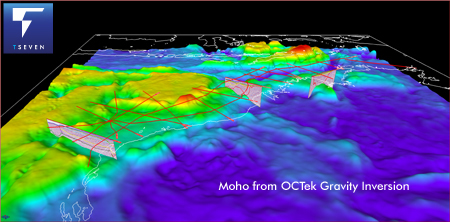OCTek Project

OCTek Seismic
The OCTek Seismic project aims to investigate the structure and tectonics of deepwater rifted margins by applying quantitative geodynamic analysis to interpretations of ION BasinSPAN seismic data. ION Geophysical have provided both the seismic data and the interpretations for the project.
Along the lines of each BasinSPAN OCTek Seismic produces a montage of profiles showing:
• Moho depth and crustal-basement thickness
• Crustal thinning factor and beta factor
• Crustal structure of the Ocean-Continent-Transition (OCT)
• Magmatic-type at the outer margin
• Variations in crustal-basement density and seismic velocity

OCTek Seismic Methodology
The OCTek Seismic project applies quantitative analytical techniques, including OCTek gravity inversion, to specific ION-BasinSPAN seismic surveys, in order to aid the interpretation and understanding of the seismic data. The techniques and their application are described below.
OCTek Gravity InversionThis is an established method, which has already been applied worldwide to produce the OCTek Gravity
Inversion reports listed on the right. Key to the success of the OCTek gravity inversion method is
the incorporation of:
• A correction for the lithosphere thermal-gravity-anomaly resulting from rifting
and breakup
• A prediction of the thickness of new volcanic crust produced by decompression
melting during breakup
OCTek gravity inversion allows us to predict depth-to-Moho and crustal-structure and display this
information on PSDM seismic sections.
Sediment-corrected (backstripped) depth-to-basement is compared with both calibrated age-dependent
oceanic-water-depths and a synthetic bathymetry profile derived from the results of the gravity
inversion. Discrepancies between the backstripped and the predictive models are known as Residual
Depth Anomalies. RDAs can be used to:
1) Identify the presence of oceanic crust and the location of the continent-ocean
boundary
2) Identify the presence, magnitude and polarity of any present-day mantle dynamic
topography
Backstripped subsidence of the basement is used to determine thinning-factors and beta-factors along
profiles. This is done using a modified version of the McKenzie subsidence model, which makes
allowance for the isostatic effects of new volcanic crust produced during rifting and breakup. The
results of the subsidence analysis are compared with the gravity inversion results which make a
similar correction.
The combined results of the subsidence analysis and the gravity inversion provide input to
petroleum-systems modelling and heat-flow studies
The joint inversion method compares the predicted Moho from the gravity inversion with the
interpreted seismic Moho, in both depth and time. The seismic and gravity Moho are brought into
coincidence by considering the lateral variations in density and velocity required to achieve this.
This:
1) Identifies possible lateral variations in basement type and character,
2) Acts as a quality control on the validity of the interpreted seismic Moho.
The combined results of OCTek Seismic analysis allow us to produce crustal cross-sections which
illustrate OCT structure, predict the presence of volcanic additions to the crust and locate the
continent-ocean-boundary.

OCTek Seismic Project invested the following geographic areas and SPAN surveys:
• The Black Sea - Black SeaSPAN
• NW shelf of Australia - WestraliaSPAN
The results will be available for purchase by anyone who has licenced the appropriate SPAN-survey or
SPAN-lines and will be available on a line-by-line basis for those who have not purchase the whole
BasinSPAN.
We believe the results from OCTek Seismic will be of assistance to:
• New Ventures exploration strategy, helping to discriminate continental and
oceanic areas, together with crustal and magmatic type, prior to any propriety data
acquisition.
•Petroleum Systems modelling, where crustal thickness estimates constrain
radiogenic heat input and beta-factors constrain the time-dependent thermal anomaly resulting from
rifting and breakup.
If you have an interest in the analysis of any BasinSPAN survey, or in the quantitative analysis of any deepwater seismic information, then please contact us